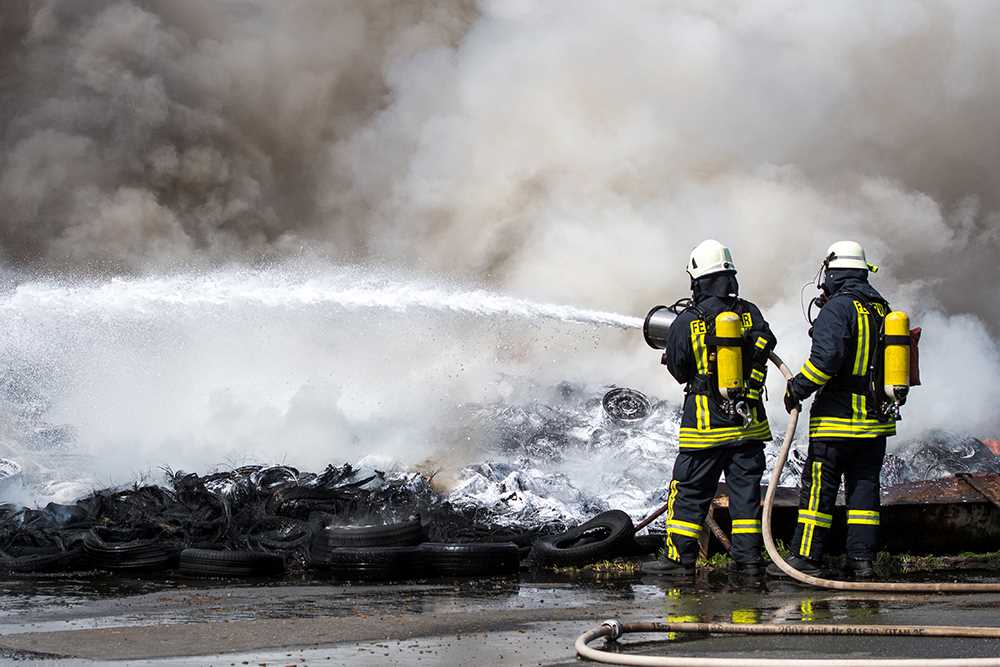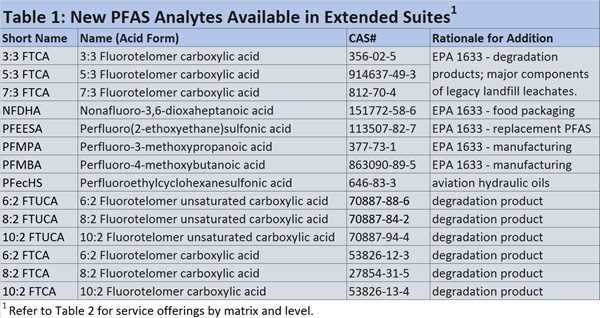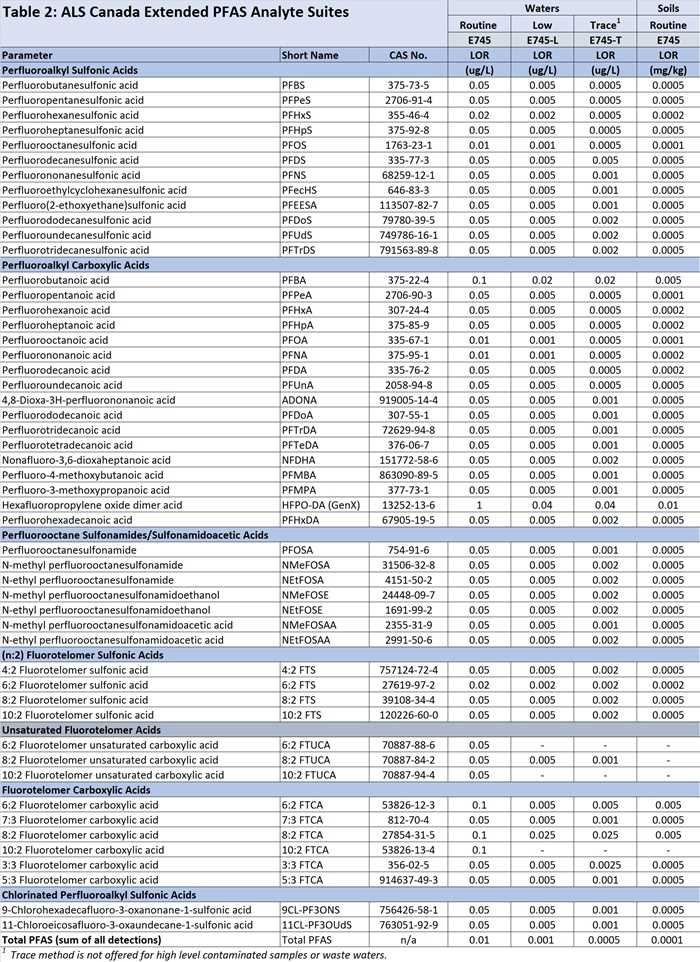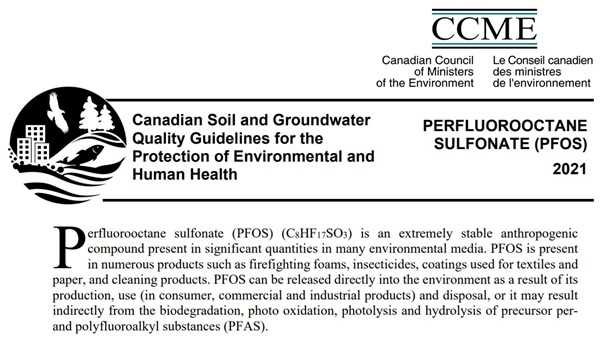Enviromail 34 canada extended pfas analyte reporting

ALS has been testing for complex suites of PFAS analytes globally under accredited methods since the late 2000's, supporting global trends to monitor and restrict these persistent chemicals in the environment. What started out as PFOS and PFOA has steadily grown into dozens of new compounds of interest as PFAS regulation and knowledge of their precursors and degradation processes increases. Globally, accredited testing laboratories typically measure up to 30 PFAS analytes, although this varies by region and provider.
The ALS global network of expert PFAS scientists are constantly developing new capabilities to meet local and global testing needs. This includes global reviews of emerging analytes, either those becoming increasingly regulated or requested by our global customers. ALS Waterloo, our Canadian PFAS specialist laboratory, is pleased to release new extended PFAS testing suites – with up to 51 analytes – incorporating our global ALS sector review and including all analytes from Draft US EPA Method 1633. Our new expanded test suites reduce the risk of underestimating cumulative PFAS, and offer detection limits well below Canadian PFAS regulations and CCME guidelines, with most below the lowest of any global PFAS regulatory guidelines from the USA, Europe, or Australia (refer to compilation published by ITRC, the US Interstate Technology Regulatory Council).
Currently Canada has formal environmental PFAS regulations only in British Columbia, however new CCME PFOS water and soil quality guidelines and a scientific criteria document were recently released (September 23, 2021), and new provincial regulatory guidelines are expected to follow. The proactive ALS expansion of analytical capabilities should provide strong support for increased regulation.
ALS extended suites now include analysis of PFecHS, found in aviation hydraulic oils, as well as fluorotelomer carboxylic acids 3:3 FTCA, 5:3 FTCA, and 7:3 FTCA, which are major components in legacy landfill leachates. All 40 PFAS analytes from EPA Method 1633 are included in all the new ALS offerings, plus up to 11 additional analytes , as shown below in Tables 1 and 2. ALS Waterloo holds ISO 17025 accreditation for all 51 of these PFAS analytes in waters, and for 47 analytes in soils.

With the creation of new suites and many more analytes, it is also important to establish LORs that maximize data quality. Some LORs have decreased, some have increased, and some are unchanged – refer to the quality considerations that follow for rationale.
Comparison to US EPA Draft Method 1633
In September 2021, US EPA issued Draft Method 1633 with new “performance-based” analytical methods guidance for PFAS testing in water, soil, biosolids, and tissue, in support of the US PFAS Action Plan and US Clean Water Act (CWA). Draft Method 1633 extends expectations for PFAS analytical testing suites at contaminated sites, and proposes new guidance for PFAS analytical test methods (subject to revision prior to EPA approval).
Current ALS Canada methods for PFAS in waters and soils meet all fundamental elements of Method 1633, including:
- LC/MS/MS with multiple reaction monitoring;
- whole sample bottle extractions for waters;
- isotope dilution where labelled PFAS isotopes are available (otherwise using extracted labelled internal standards);
- solid phase extraction for lowest required detection limits;
- extensive cleanups to remove interference; and
- quantification of both linear and branched PFAS isomers.
EPA Method 1633 is performance-based, therefore changes are permitted to non-prescriptive elements of the method, such as extraction techniques, sample volumes, cleanup procedures, etc., where performance expectations are met. Performance criteria will be defined in the final approved version of the method, after multi-laboratory validation studies are complete. The ALS Canada PFAS methods are fully validated, reviewed and authorized by QA and senior technical leadership, and accredited to ISO 17025 by CALA. We are confident that our methods will meet the performance criteria from EPA 1633 when they become available.
Quality Considerations with Limits of Reporting (LORs)
With ALS extended suites now available, along with a new trace method for waters, it is also time to refocus on maximizing data quality and minimizing false positives. False positives can cause significant issues particularly if PFAS are detected in sensitive receptor or control samples that should be free of PFAS. From both a field and laboratory perspective, the challenging issue over the last decade has been how to avoid cross-contamination from ‘mid-plume’ contaminated groundwater samples to clean samples collected and analyzed together, where analyte concentrations may differ by three to five orders of magnitude. This is despite dedicated field equipment and best field practice of sampling from lowest to highest impacted sites. The challenge to reduce cross-contamination includes field handling, shipment, storage, and laboratory protocols. In addition, as per normal industry practice, ALS will not be able to report low or trace level LORs for low level substances in the presence of very high concentrations of other target PFAS compounds.
When reaching a laboratory environment, ‘clean’ and ‘dirty’ sample segregation becomes even more critical with larger analyte suites, and every order of magnitude lower in testing becomes infinitely more challenging. From the ALS experience of decades of analyzing thousands of PFAS samples per week, our scientists believe that optimum data quality is achieved by not pushing to see the lowest possible detection limits in sites/samples with high potential impact, but by offering a series of methods designed to meet specific client needs. For this reason, the ALS LORs offered with our extended suites have slight changes. Where control samples or critical receptor sample monitoring is required to trace levels, this can now be achieved through a new trace method, which uses enhanced internal laboratory segregation and controls to minimize potential false positives through the entire measurement process – delivering higher quality data.
Sampling Considerations
The new ALS extended suites and trace level water method can be obtained from the same 60 mL sample bottles currently used for our regular suite of PFAS targets, however low level and trace methods require duplicate bottle submission. ALS also strongly recommends that pristine samples for the new trace level water method (E745-T) should be separately bagged and marked “TRACE PFAS ONLY” when submitting to ALS. Through this segregation in the field and laboratory your data quality can be maximized.
Sodium thiosulfate is added to PFAS water samples for dechlorination (only required for chlorinated waters). Samples should be chilled and submitted to the laboratory within 48 hours of sampling. EPA Method 1633 indicates that some perfluorooctane sulfonamide ethanols and perfluorooctane sulfonamidoacetic acids may potentially degrade into other PFAS compounds beyond 7 days (at ≤6˚C). ALS will therefore freeze any samples that cannot be extracted within 7 days of sampling.

Should you be interested in receiving this wider scope of analytes or new Trace LORs (for applicable samples) on your project, please contact your ALS Account Manager or ALSWTinfo@alsglobal.com for more information.






















































